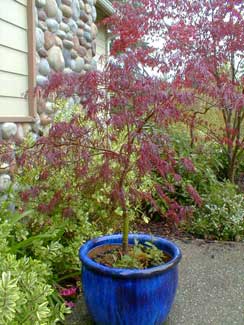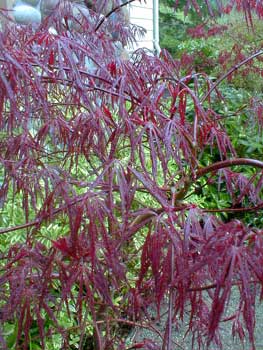
'Red Dragon'
Lace-leaf Japanese Maple
"Once again the maple blushes,
blushes rosy, rosy red."
-James Edwin Campbell
(1867-1896)
(1867-1896)
These two photos from April show Acer palmatum var dissectum forma atropurpureum 'Red Dragon' laceleaf Japanese maple, a potted specimen-plant near the front stoop of a friend's house.
 This one might or might not remain a bonsai subject rather than for the open garden. In form it is mounding & weeping, but not all specimens weep so much as to seem like a formal fountaining mound such as 'Crimson Queen.'
This one might or might not remain a bonsai subject rather than for the open garden. In form it is mounding & weeping, but not all specimens weep so much as to seem like a formal fountaining mound such as 'Crimson Queen.'Although greatly reliant on its training when still young, 'Red Dragon' in general remains at maturity loosely structured showing its appealing form, again in sharp contrast to the densely foliaged 'Crimson Queen.' However, if never trained or pruned, it can become decreasingly airy.
'Red Dragon' will not grow true from its seeds, & is propagated from cuttings & grafts. Virtually all commercially prepared specimens are grafted onto regular A. palmatum rootstock, so there are low-graft & high-graft versions available.
This potted specimen is high graft so has lengthened upright central trunk. Low-graft versions are usually trained to an appearance that is more strongly weeping & more densely foliaged. But some low-grafts are staked up for an upright central trunk.
It needs rich humic, neutral to acidic, moist & well draining. Growth rate is slow, though young specimens develop more rapidly at six or eight inches per year, & will at first require attentive training to develop the most artful form.
After it is well trained & shaped during its youth, the slow rate of growth into maturity means it will retain its shape without constant attention. It also means that if it is badly pruned it can be slow to recover good form, so every cut must be very carefully considered.
Over time it can become wider than tall, though it is trainable to retain a narrower form. It can take on a fairly rugged aged look with many branchings even as a young tree.
As a semi-dwarf it is usually encountered in the three to five foot range (at the ten-year age), but seven or eight foot specimens are not uncommon, & over a great length of time it will become still larger.
Laceleaf maples (also called threadleaf or Cutleaf) are sometimes more delicate & prone to sun-scorch on their leaves or bark, but 'Red Dragon,' developed by Duncan & Davises of New Zealand, is robust & can tolerate more sun than other dissectum cultivars, though dappled sunlight/partial shade is still best.
This 'Red Dragon' had its sun-hardiness sorely tested in 2005. It became over-sunned & was insufficiently watered during a record-breaking summer drought & most of its leaves dried out on the branches. For a few weeks there was some worry it had died, but with more attention to its watering schedule, it soon releafed & has been healthy ever since.
Its finely dissected leaves are said to resemble dragon claws, hence the name. These leaves are a gorgeous purple-red at emergence in April, darkening to a purple burgundy which it holds strongly throughout summer.
The leaves turn bright-bright red in Autumn. The bark of young limbs is purple to nearly black, quite striking in winter when leaves are gone.